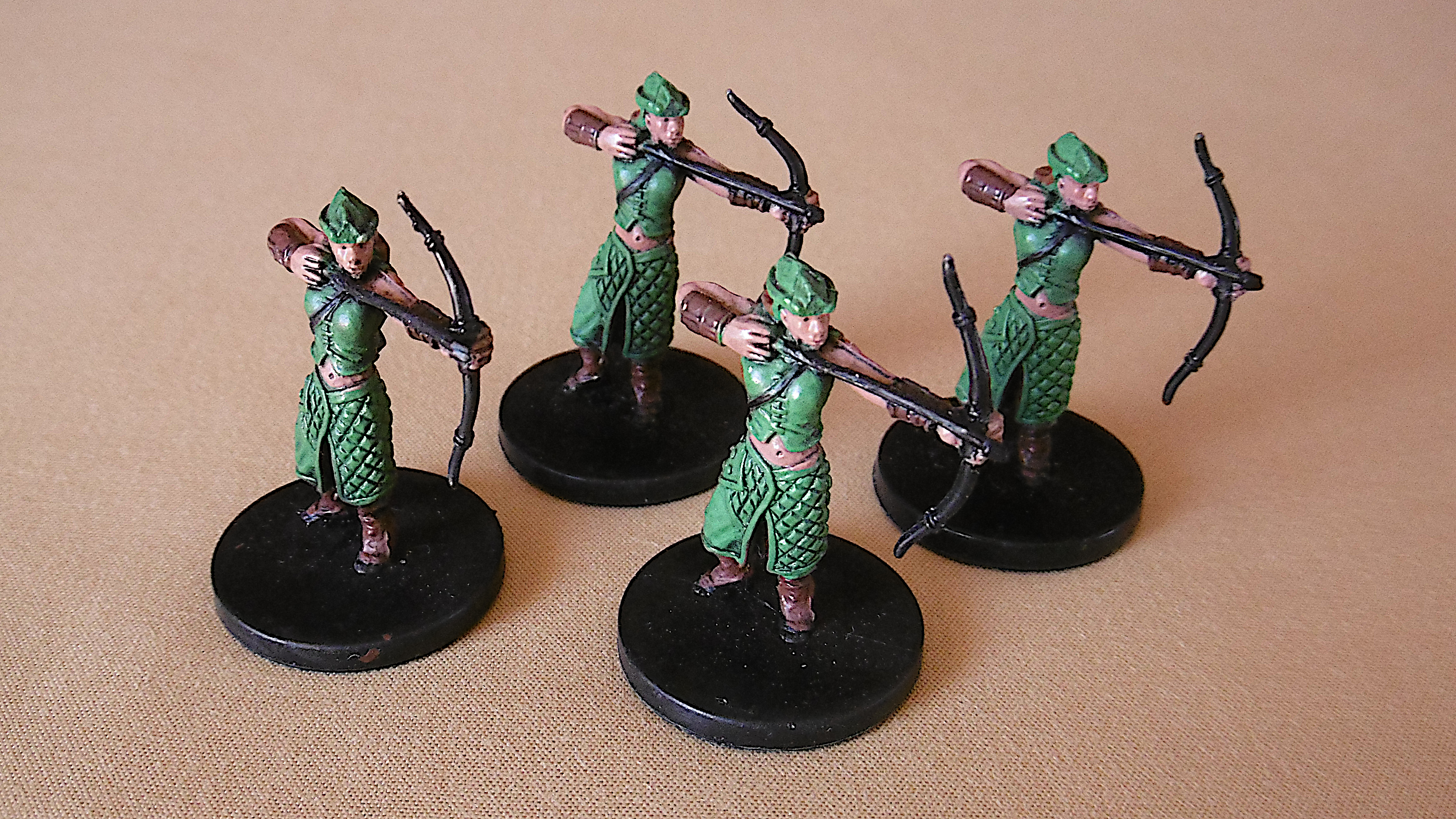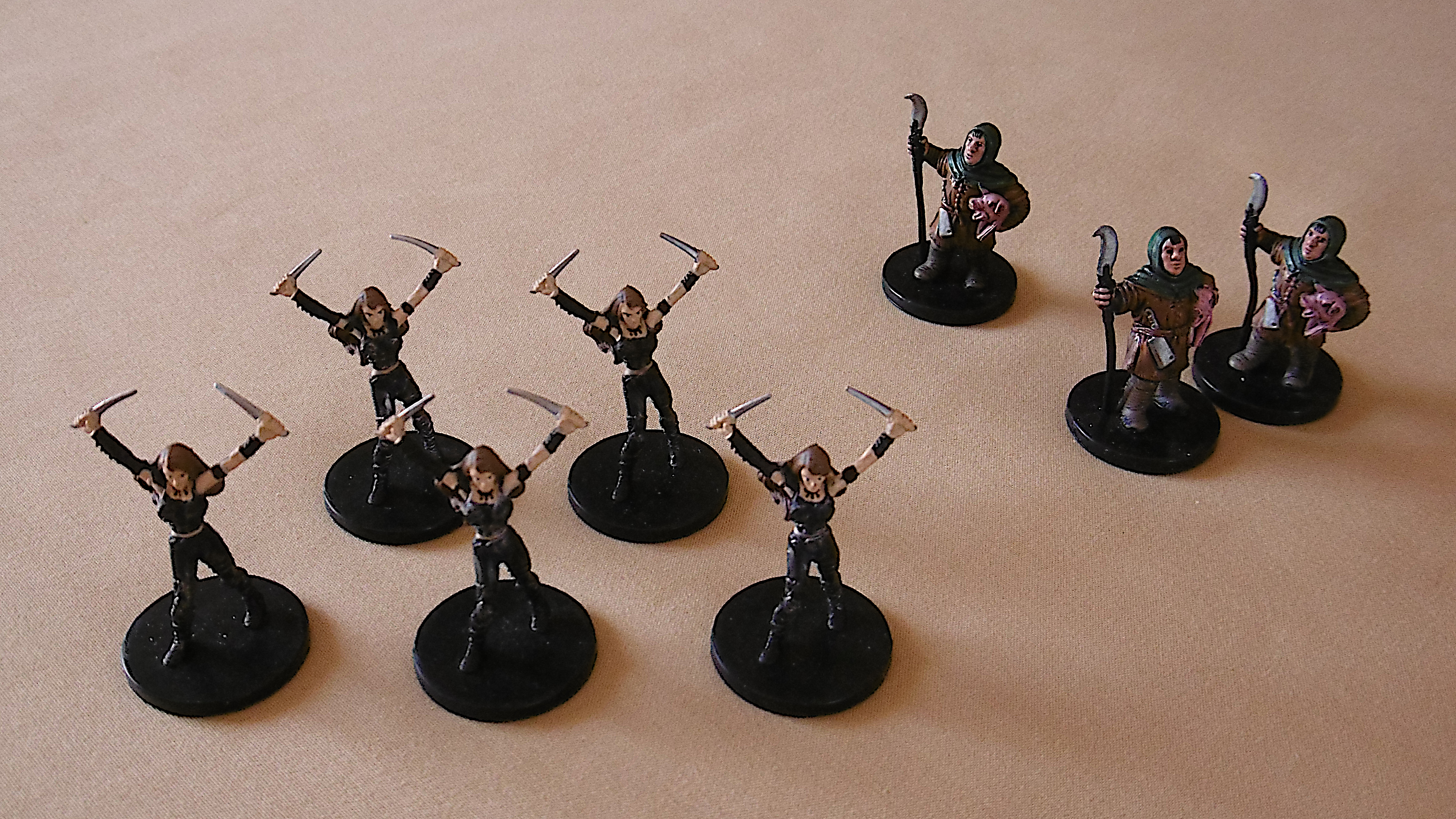“The ratio of figures to men assumed is 1:20, the ground scale is 1″:10 yards, and one turn of play is roughly equivalent to one minute of time in battle. The troop ratio will hold true for 30mm figures, but if a smaller scale is used it should be reduced to 1:10” (Chainmail, 8).
Figure Scale
In the 2000s, I collected an embarrassing number of plastic fantasy figurines. Inexpensive and pre-painted, D&D Miniatures are 30mm scale. Perfect. Except they are mounted on a circular base. A man-sized model takes up a one-inch-diameter space, which fits in the five-foot square occupied by the character on a twenty-first century battle grid.
Wargame miniatures often have rectangular bases, which correspond to the breadth and depth of the unit represented. Transposing its one-inch base to the battlefield, my man-sized figurine represents 20 men milling about in a hundred square yards.
A wave of the hand seems an easy solution. I respect the breadth but ignore the figure’s depth. The 20 men are in formation at the front edge of the space occupied by the figure. In the case where multiple figures make two or more ranks, all troops represented are in ranks, one behind the other, irrespective of the scaled depth.

Each figurine represents a number of troops in a rank across the leading edge of the front rank of figures.
Using the larger scale without also using smaller figurines impacts play in two other ways. One, areas of effect, while scaled accordingly, more frequently touch a larger base. A near miss on Gygax’s table is a hit on my table. Two, shorter distances present less spectacle. A giant hurling a rock 20 inches downrange on an eight-foot table looks the same as the scaled ten-inch throw compared to my four-foot table. But, as the giant in both cases is three inches tall, the shorter throw appears less impressive.
To compensate for the former, I might use a longer “variation measure” (Chainmail, 13) for field guns and giant throws. I’m not sure, though, that this won’t have some other unintended impact.
Ground Scale
“The playing area that the battles are fought out upon should be a table rather than the floor. It can be from a minimum of 4′ to a maximum of 7′ wide, and it should be at least 8′ in length” (Chainmail, 5).
Gygax was famous for hosting wargames on a large sand table in his basement. The largest table I have—upon which I must also dine—measures 31″ × 47″. I could run small engagements in the scaled 310-by-470 yards, but Light Horse charge across it in a single turn, and a figure anywhere on the table is a target for Longbowmen stationed in the center.
I stretch the table by doubling the ground scale. At 20 yards to the inch, the battlefield is 620 yards by almost a thousand. It’s similar to playing on a five-by-eight-foot table. But not quite. The figurines remain the same size, so they effectively take up four times the space on my battlefield than they would on Gygax’s basement table. On my table, commanders lack the same room for maneuver.
Figure-to-Troop Ratio
Because a one-inch base now stretches across 20 yards, I up the figure scale as well. At the corresponding figure scale, I could field armies the same size as Gygax, but 1:80 sounds unreasonable.
To approach the calculation another way, I count men in one rank at Bath’s “very close order” (Ancient Wargaming, 20).1 In the closest formation, each man occupies only 18 inches.
At 18″ per, 40 fighters fit in one rank 60 feet (20 yards) wide. Therefore, at 1:40, a rank of figures, bases touching, are in very close order. As per Chainmail, figures up to 1″ apart are in close order, and any farther is open order.2
Scale for the Valormr Campaign
Ground Scale: 1″ to 20 yards*
Figure Scale: 1:40
Time Scale: 1 minute per turn* To convert, all distances given in Chainmail are halved.

Left to right: a lone figure represents 40 troops in one rank at close order unless otherwise stated; 120 Heavy Spears, one rank, very close order; two ranks of 80 each Armored Foot, close order; two ranks3 of 160 Armored Spears, the first presents a shield wall, very close order.
Troop Types
According to Bath, light foot “wear no armor of any description, either leather or metal. They may carry a light shield and are usually but not always armed with missile weapons” (16). Gygax & Perren imply as much in the missile fire table (Chainmail, 11), where targets are categorized as unarmored, half-armor [another word for Heavy or Medium (Bath, 16)] or shield, and fully armored.
Since most any combat-capable characters in D&D wear some sort of armor, it is the rare figurine in my collection which could be considered Light Foot. I, therefore, adjudicate by case, according to my needs, whether to class a lightly-armored figure as Light or Heavy.
Furthermore, there is a dearth of mounted figures in the D&D Miniatures line. Again, I take the liberty to call any figure mounted, thus turning Foot into Horse as desired.

In Champions of Chaos, these figures wearing leather armor (foreground) are classed as Light Foot. They stand in open order. Others (background) are peasants in milling-about formation.
My reading of Chainmail gives Light Foot a sore disadvantage. They move and charge at the same rate as Heavy Foot, get no more attack dice than an equal number of points of Heavy Foot, and suffer weak morale. I suspect this is by design, being historically—and logically—accurate. In historical wargames, as in early fantasy games, a force adhered to percentages of troop types. We see such orders of battle in Bath’s Hyboria, Arneson’s Blackmoor (First Fantasy Campaign), and as recently as the AD&D Monster Manual. I assume a player bought only as many Light Foot as the order of battle required. Though anachronistic, the cliché is apt—cannon fodder.
I haven’t yet worked out the orders of battle for the Valormr Campaign. These Light Foot are a nod in that direction, as are the peasants, who Solon Theros herded from the countryside to fill the ranks.
Notes
1 Bath seems to have invented the term “very close order” to differentiate from close order. Historically, close order is less strictly defined, meaning troops spaced anywhere from 18″ to 36″ apart. Gygax and Perren make no mention of “very close order.” Chainmail gives advantages to pole arms formed in close order, given as figures “1″ or less apart” (Chainmail, 40).
2 Chainmail makes no distinction of, nor has rules for, extended order. We’ll leave it at that for now.
3 Chainmail allows only a formation’s first rank of figures to engage in melee. I am not sure why that is. In the historical phalanx, men armed with spears could engage targets from the second rank and with pikes (up to 20′ long) from as far back as the fifth rank. Maybe Gygax and Perren assume each figure is in multiple ranks, but then the figure’s width cannot accurately depict the formation’s breadth.